ABSTRACT
The study is on “alkaline and bacterial pretreatment of rice straw and water hyacinth for biogas production in a batch bioreactor”. The study has nine aims and objectives. Several factors affect the yield of biogas in a bioreactor. In order to determine the optimal conditions required for the production of biogas, it was achieved by optimizing several factors that are critical in stages of the production line. These include the substrate, the amendments, and the Hydraulic Retention Time (HRT). The substrate is the most important component of any bioreactor other than the microorganisms. The substrates in this study, rice straw and water hyacinth, are rich is cellulose which is documented to be the most abundant substrate on earth. We therefore sought to obtain the high energy that is stored in this substrate and harness it for biogas production. To achieve this, we carried out both biological and chemical pretreatment of the substrate. Pretreatment is necessary because ordinarily, this substrate could take between weeks to months to undergo degradation into simple sugars needed for biogas production. A combination of thermal and chemical pretreatment was adopted as strategy for chemical pretreatment using alkaline.
CHAPTER ONE
INTRODUCTION
1.1 Background of Study
Over the past century, the rapid rise in the dependence on petroleum and its allied energy industries has contributed to a rapid rise in the world economy. It has been under looked that the underlying energy resource in the form of fossil fuel can deplete and therefore is a limited form of energy. It cannot be overemphasized also that combustion of these products contributes to emissions of greenhouse gases (e.g. fossil fuel-derived carbon dioxide (CO2) emissions) which have become a global concern, since about 88% of global energy consumption derived from fossil fuels (Achinas et al., 2017; Agency, 2015). Therefore, developing and developed countries have made efforts towards overcoming the environmental challenges and overdependence on fossil fuels by increasing their proportion of renewable energy to between 20-40% by 2020 (Karmellos et al., 2016). For instance, Progress towards this target is measured every two years and was proposed on 30 November 2016 to reach at least 27% renewables in final energy consumption in the EU by 2030 (Scarlat et al., 2018).
Among other renewable energy sources, Biogas is seen as one of the most promising renewable energy resources that can replace part of the fossil fuel-based energy used today, and it shows great potential and many advantages, including both climate and economic benefits (Meyer-Aurich et al., 2016). Considering its accessibility to all, a biogas process can be implemented in small or large scale by the wealthy or poor, which is important when designing flexible and sustainable energy solutions in both industrialized and developing countries (Holm-Nielsen et al., 2009) as opposed to fossil fuels. Substrates or raw materials used in the production of biogas can be sourced by rural dwellers which includes but not limited to various types of waste products, such as manure, straw, municipal wastewater, food waste etc., and dedicated energy crops (Vasco-Correa et al., 2018; Appels et al., 2011). This implies that if the technology is implemented, it can be a source of employment therefore reducing the poverty index of Nigeria which is currently on the increase (Ogujiuba, 2015). Among the substrates used in the production of biogas, lignocellulosic materials, such as agricultural residues, are of great interest due to their high abundance and potential for biogas production (Azman et al., 2015). Environmentally, Adoption of Biogas technology will effect controlled waste collection as opposed to dumping household waste in landfill or storing farm manure in open tanks. This can not only have a down surge on the number of waste deposits, but also to decrease emissions of carbon dioxide and other greenhouse gases (Borjesson & Mattiasson, 2008).
Biogas is a rich technology that adopts complete diversification of organic waste into energy, economically and environmentally rich products. The biogas produced, containing the energy carrier methane, can be used for production of heat, electricity and vehicle fuel after upgrading (removal of carbon dioxide and trace gases) (Holm-Nielsen et al., 2009). The residues left after biogas production are rich in mineral nutrients and can be used as a fertiliser during crop production to replace fossil energy-requiring mineral fertilisers, thus enabling recycling of nutrients between urban and rural areas (Vasco-Correa et al., 2018; Möller & Müller, 2012; Weiland, 2010; Holm-Nielsen et al., 2009).
The Bio refineries of biogas technology are the microorganisms which are vital in their consortium and their diversified metabolic capabilities for degrading the wastes or organic rich substrates into desired products. (De Francisci et al., 2015). To obtain a stable biogas process, all these conversion steps and microorganisms must work in a synchronised manner (Vanwonterghem et al., 2014a). When plant-based materials (e.g. agricultural residues) are used for biogas production, the first step of the microbiological process, hydrolysis, becomes rate-limiting. This is the major limitation of the use of cellulolytic materials since the crystalline structure of the lignocelluloses obstructs degradation in the initial step, thus, slowing down the hydrolysis of these insoluble compounds into lower polymers (Mulat & Horn, 2018; Lynd et al., 2002a; Noike et al., 1985).
However, several efforts have been made to overcome the obstacle associated with the degradation of lignocellulosic and the-like materials through the adoption of several pretreatment methods that would expose the material and increase its accessibility to biological attack (Martínez-Gutiérrez, 2018). Similarly, engineering the microbial consortium is an alternative method which can be characterized by adding lignocelluloses degrading microorganisms to the batch digester. The quest for bacteria and fungi with lignocelluloses-degrading activities have been on-going in soil ecosystems (Tsavkelova & Netrusov, 2012; Lynd et al., 2002a; Do et al., 2018; Ransom-Jones et al., 2012; Morrison et al., 2009b; Miron et al., 2001), while only a limited number have examined cellulose-degrading bacteria in biogas digesters (Jia et al., 2018; Bozan et al., 2017; Sun et al., 2013; Yan et al., 2012). Consequently, insufficient information is available on cellulose-degrading communities in biogas processes and on possibilities to enhance the degradation rate by ‘microbial steering’, i.e. by supporting the growth of highly efficient cellulose-degrading bacteria or communities. This study therefore seeks to employ mechanisms that would contribute to the exposure of lignocelluloses to microbial attack through the adoption of several physicochemical and biological methods.
1.1 Statement of Problem
According to Adeleye and Okorondu (2015), Energy and Environmental Sustainability are two most pressing needs in the world today. Abundant energy available for use from fossil fuels are not cheap, accessible and ecofriendly. There is therefore the need to explore other sources of energy with promising capabilities such as eco-friendliness, accessibility and cheaper cost. More research have been drifted towards the bioconversion of cellulolytic materials that are abundant in agro wastes (Braide et al, 2016). Cellulose, trapped in agricultural residues, has been accounted to be the most abundant organic compound on earth, estimating about 1011 tons of cellulose that are synthesized each year (Matsuoka et al., 1996; Son et al., 2002). This figure accounts for more than 50% of the bound carbon on earth. According to US National Petroleum Council (2007) and Smeets et al. (2007), the estimated global annual production of biomass is 1 × 1011 tons, sequestering 2 × 1021 J of energy and when compared to annual petroleum production which amounts to 2 × 1020 J, the technically recoverable endowment of conventional crude oil is 2 × 1022 J (Smeets et al., 2007). This means that in only one decade, Earth’s plants can renew in the form of cellulose, hemicellulose, and lignin all of the energy stored as conventional crude oil. Therefore, the challenge for scientists is to access these polymers and convert them into fuels and building blocks for civilization (US National Petroleum Council, 2007).
1.2 Aim and Objectives
The aim of this study is to evaluate the effect of alkaline and bacterial pretreatment of rice straw and water hyacinth on biogas production in a batch bioreactor system with the following specific objectives viz:
- To isolate lignolytic Bacteria from the termite gut and upscale them to desired biomass for biological pre-treatment of the feed stock.
- To determine the optimum conditions for chemical pretreatment (Using NaOH) using Box Benken design (RS-Modelling).
- To pre-treat the rice straw with different Treatments (Chemical) at predicted levels of Concentration, Mass of substrate and Time of exposure obtained from Optimum conditions of Box-Benken RS-Model.
- To determine the lignin content in the pre-treated and un pretreated samples.
- To determine the biogas yield from single and combined combination of substrate following Anaerobic Digestion(AD).
- To evaluate the effect of supplementation of alkaline and bacterial pre-treated feed stock with different ratios of nitrogen sources on biogas production.
- Determination of biogas composition by Gas Chromatography technique.
- Optimization of the parameters that gave the highest yield of biogas.
- Study the microbial succession of the organisms in the digesting slurry during the course of digestion.
- Determine the physico-chemical composition of the digesting slurry before and after Anaerobic digestion.
Justification of Study
Several work has been done to isolate, characterize and identify isolates with cellulose degrading systems which is also studied in this work. Similarly, the use of physicochemical pretreatment techniques will also be reviewed and adopted in this work. However, Works published on biomethenation or biogas technologies do not adopt the response surface modelling for the production of improved products under controlled physiological conditions. Similarly, this research tend to adopt several combinations of different wastes from cellulolytic and animal farms for the improved digestion of lignocelluloses and also explore waste management.
Pages: 163
Category: Project
Format: Word & PDF
Chapters: 1-5
Material contains Table of Content, Abstract and References.




